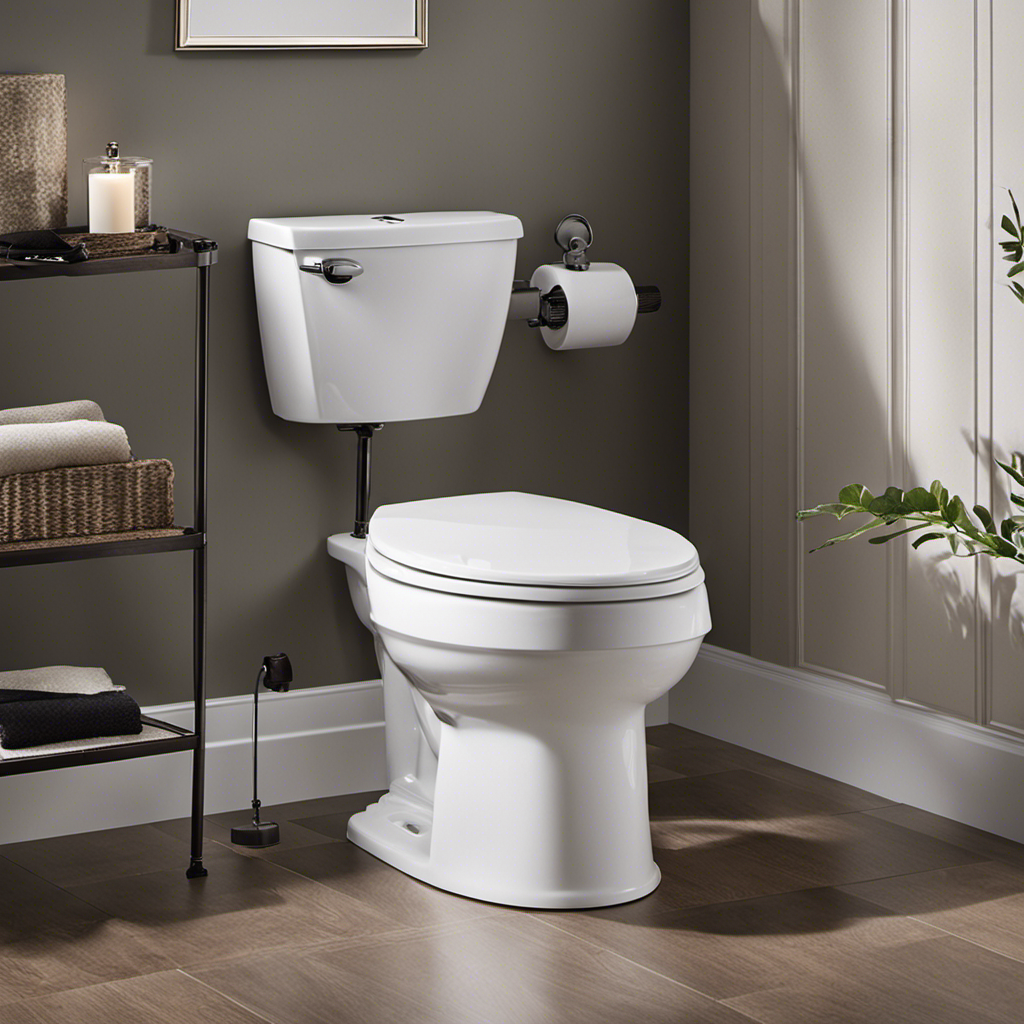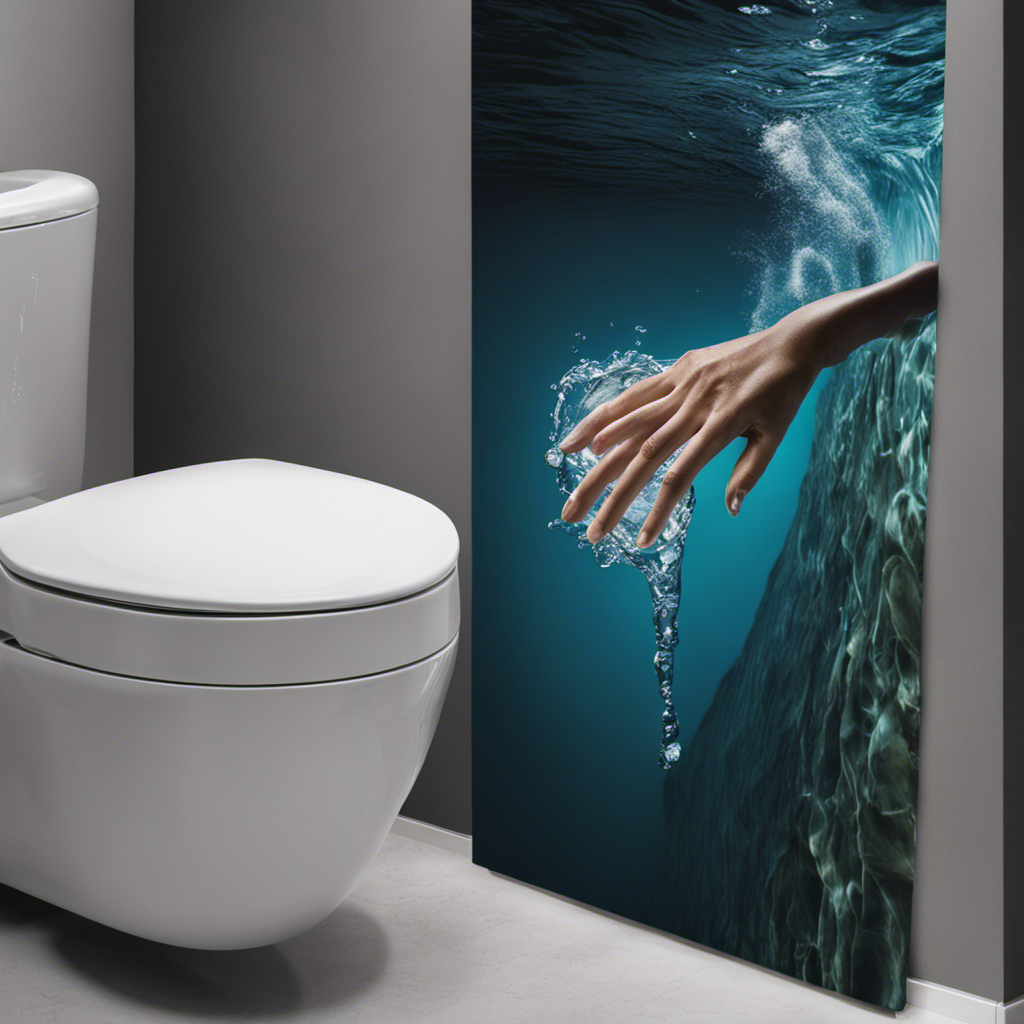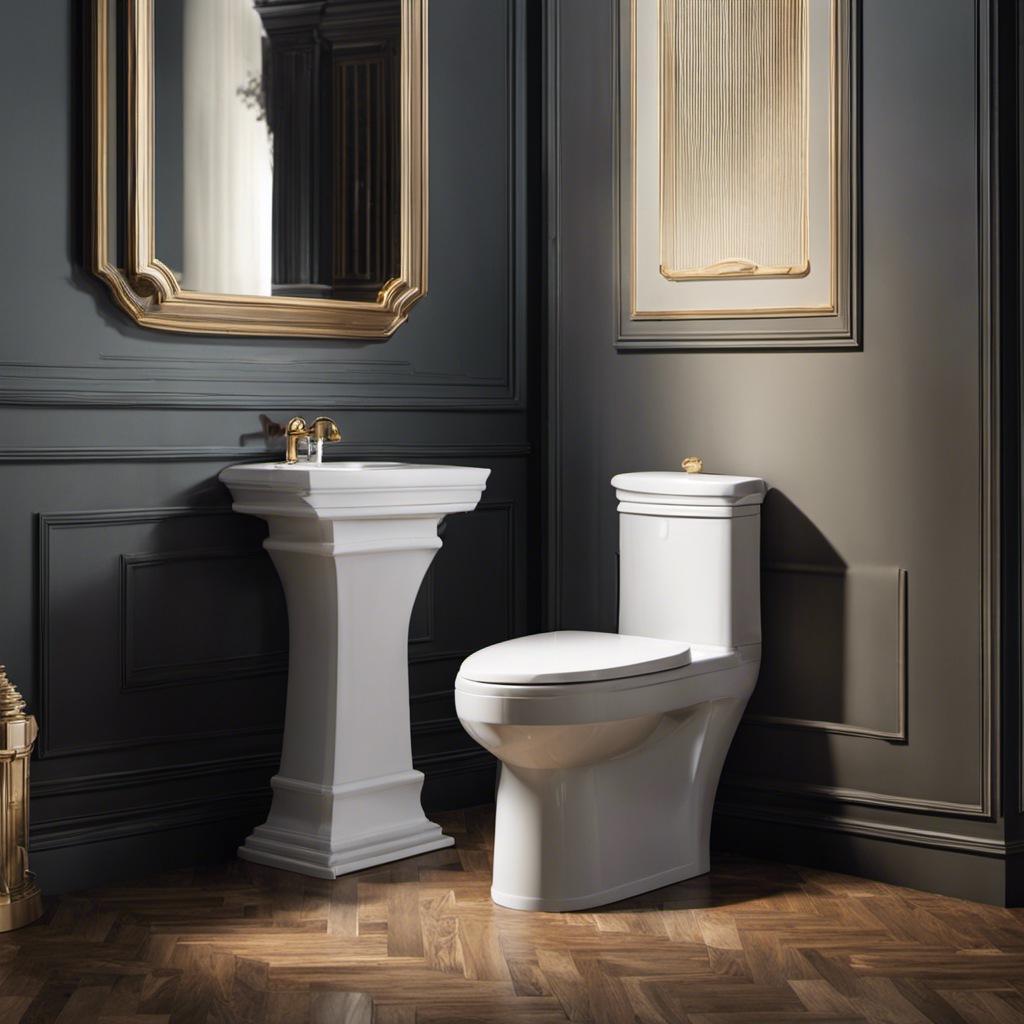Hey there! Did you know that the average person spends about 3 years of their life sitting on the toilet?
Well, if you’re looking to upgrade your porcelain throne, you’ve come to the right place. In this article, I’ll guide you through the step-by-step process of installing a new toilet.
From gathering the necessary tools to testing for leaks, I’ll provide you with all the technical details you need to get the job done right.
So, let’s dive in and transform your bathroom into a modern oasis!
Key Takeaways
- Read manufacturer’s instructions thoroughly
- Properly align wax ring with toilet flange
- Avoid overtightening bolts
- Test for leaks after installation
Gathering the Necessary Tools and Supplies
Now that you’ve got all the necessary tools and supplies, it’s time to move on to the next step of the installation process.
When it comes to installing a new toilet, there are a few tips to keep in mind to ensure a successful installation.
First, make sure to read the manufacturer’s instructions thoroughly before starting. This will provide valuable information on specific installation requirements for your particular toilet model.
Additionally, avoid some common mistakes that can be easily overlooked. One such mistake is not properly aligning the wax ring with the toilet flange, which can lead to leaks. Another mistake is overtightening the bolts, which can crack the toilet bowl.
Removing the Old Toilet
To start, you’ll want to carefully disconnect the water supply line from the old toilet. This is an important step in removing the old toilet safely and efficiently. Once the water supply line is disconnected, you can proceed with the removal process.
Here are some toilet removal techniques to consider:
- Turn off the water supply valve to prevent any water leakage.
- Empty the toilet bowl and tank by flushing multiple times.
- Disconnect the bolts securing the toilet to the floor using a wrench or pliers.
- Lift the toilet carefully, being cautious of its weight and size.
Proper disposal of the old toilet is equally important. Here are some tips to consider:
- Contact your local waste management facility for guidance on proper disposal methods.
- If the toilet is still in good condition, consider donating it to a charity or organization in need.
- Recycle any parts of the toilet that can be recycled, such as the porcelain or metal components.
Preparing the Area for the New Toilet
Before installing the new toilet, there are a few key points to consider.
Firstly, I need to clear any existing fixtures in the area, making sure there are no obstructions or debris that could interfere with the installation process.
Secondly, I must measure the available space to ensure that the new toilet will fit properly and comfortably in the designated area.
Lastly, it is crucial to check for a reliable water supply to connect the toilet to, as without proper water supply, the toilet will not function effectively.
Clear Existing Fixtures
First, you’ll need to remove the existing toilet fixtures. This is an important step in preparing the area for the new toilet. Here’s what you’ll need to do:
-
Clearing debris:
-
Start by removing any items or clutter around the toilet area. This will give you enough space to work comfortably and safely.
-
Use a broom or a vacuum cleaner to clear any loose dirt or debris around the toilet. This will ensure a clean and hygienic environment for the installation process.
-
Disposing of old fixtures:
-
Carefully detach the water supply line from the toilet tank. Make sure to turn off the water supply before doing this to avoid any leaks.
-
Next, remove the bolts that secure the toilet to the floor. You may need a wrench or pliers for this step.
-
Lift the toilet off the floor and place it on a tarp or old towels to catch any remaining water. Dispose of the old fixtures responsibly, following local regulations for proper waste disposal.
Now that you’ve cleared the existing fixtures, it’s time to measure the available space for the new toilet.
Measure Available Space
Now that you’ve cleared the existing fixtures, you’ll need to measure the available space for the new toilet. It’s crucial to choose the right toilet size to ensure a proper fit and efficient functionality.
To do this, follow these simple steps:
-
Measure the rough-in: This refers to the distance between the wall behind the toilet and the center of the drainpipe. It typically measures 12 inches, but it’s essential to confirm this measurement before purchasing a new toilet.
-
Measure the width: Measure the distance between the side walls or any obstructions near the toilet area. Make sure to leave enough space for comfortable usage and cleaning.
-
Measure the length: Measure the distance from the back wall to the front of the existing toilet. This will help determine whether you have enough space for the new toilet.
Check for Water Supply
Make sure you check if there’s a reliable water supply near the area where the toilet will be placed. This is an essential step in the installation process to ensure that the toilet functions properly.
Here are some key points to consider when checking the water supply:
-
Water Pressure: Before installing a new toilet, it’s crucial to check the water pressure in your plumbing system. Low water pressure can affect the flushing capabilities of the toilet, while high water pressure can cause leaks and damage. Use a pressure gauge to measure the water pressure and make sure it falls within the recommended range.
-
Shutting off the Water Supply: Before starting any installation work, it’s important to shut off the water supply to the toilet. Locate the shut-off valve, usually located on the wall behind the toilet or near the floor, and turn it clockwise to shut off the water flow. This will prevent any water leakage during the installation process.
-
Inspecting the Water Supply Line: Take a close look at the existing water supply line to ensure it’s in good condition. Look for any signs of wear, cracks, or leaks. If you notice any issues, it’s recommended to replace the supply line with a new one to avoid future problems.
Installing the New Toilet Bowl
When installing a new toilet bowl, there are three key points to consider: proper alignment and leveling, securing the toilet securely, and sealing for water tightness.
To ensure proper alignment and leveling, it’s important to use a level and adjust the toilet until it is perfectly level in all directions.
Securing the toilet securely involves using bolts and washers to fasten the toilet to the floor, ensuring it remains stable and doesn’t wobble.
Lastly, sealing for water tightness is crucial to prevent any leaks. This can be achieved by applying a wax ring or a rubber gasket between the toilet and the flange.
Proper Alignment and Leveling
To ensure proper alignment and leveling, it’s important to use a level and adjust the toilet accordingly. This step is crucial to ensure that the toilet sits evenly on the floor and prevents any leaks or damage in the future.
Here are some key steps to achieve proper leveling and toilet alignment:
-
Use a level: Place a level on top of the toilet bowl and check if it is level from side to side and front to back.
-
Adjust the toilet: If the level indicates that the toilet is not level, you will need to adjust it. Start by placing shims or wedges under the low side of the toilet to level it out.
-
Check for stability: Once the toilet is level, check for stability by gently rocking it. If it wobbles, adjust the shims or wedges until it feels secure.
Securing the Toilet Securely
Securing the toilet securely ensures that it remains stable and prevents any potential leaks or damage in the future. To achieve this, you need to properly secure the toilet bolts.
Begin by placing a wax ring on the flange, ensuring that it is centered. Carefully lower the toilet onto the wax ring, aligning the bolt holes with the bolts on the flange. Gently press down to compress the wax ring and create a tight seal.
Now, it’s time to secure the toilet. Start by hand-tightening the nuts onto the bolts, making sure the toilet remains level. Use a wrench to tighten the nuts further, but be cautious not to overtighten and crack the base.
To check the stability, gently rock the toilet back and forth. If it moves, tighten the nuts a bit more until it feels secure.
Sealing for Water Tightness
Now that the toilet is securely fastened to the floor, the next step in installing a new toilet is to ensure a watertight seal. This is crucial to prevent any leaks or water damage in the future.
There are several waterproofing methods that can be used to achieve a tight seal:
-
Wax Ring: This is the most common method used to seal the toilet to the floor. A wax ring is placed on the flange, which is then compressed when the toilet is bolted down, creating a watertight seal.
-
Rubber Gasket: Another option is to use a rubber gasket instead of a wax ring. This gasket is placed on the flange and provides a tight seal when the toilet is installed.
-
Caulk: In addition to using a wax ring or rubber gasket, it is also recommended to apply a bead of caulk around the base of the toilet. This helps to further seal any gaps and prevent water from seeping through.
It is important to take the time to ensure a tight seal when installing a new toilet, as this will help to prevent any future water damage or leaks.
Attaching the Toilet Tank
Attach the toilet tank by connecting the water supply hose to the bottom of the tank.
The flushing mechanism and toilet seat installation are crucial steps in this process.
First, make sure the flushing mechanism is properly aligned with the inside of the tank. This mechanism controls the water flow and flushes waste efficiently.
Next, attach the toilet seat securely to the bowl using the provided hardware. Ensure that it is centered and level.
Once the flushing mechanism and toilet seat are in place, it’s time to connect the water supply. This is done by attaching one end of the water supply hose to the bottom of the tank and the other end to the water supply valve on the wall.
Tighten the connections with a wrench to prevent leaks.
With the tank attached and the water supply connected, the toilet is now ready for use.
Connecting the Water Supply
Once the flushing mechanism and toilet seat are in place, it’s time to connect the water supply by attaching the water supply hose to the bottom of the tank. This step is crucial to ensure a proper flow of water into the toilet. Here’s how to connect the water supply:
-
Start by locating the water supply valve, usually found on the wall behind the toilet.
-
Turn off the water supply by turning the valve clockwise.
-
Next, connect one end of the water supply hose to the valve.
-
Make sure to tighten the connection using a wrench to prevent any leaks.
-
Now, take the other end of the hose and attach it to the fill valve at the bottom of the toilet tank.
-
Ensure a secure connection by hand tightening the nut.
-
Do not overtighten as it may cause damage.
-
Once the hose is securely attached, turn on the water supply by turning the valve counterclockwise.
-
Check for any leaks and make adjustments if necessary.
Testing the New Toilet for Leaks
To test for any leaks in your newly connected water supply, you can turn on the water valve and observe carefully for any signs of water leakage. This step is crucial in ensuring that your toilet is properly installed and functioning correctly. There are several testing methods you can use to troubleshoot leaks. One method is to visually inspect the area around the toilet base and water connections for any water accumulation or dampness. Another method is to place a few drops of food coloring into the toilet tank and wait for a few minutes. If the water in the toilet bowl changes color, it indicates a leak. Additionally, you can use a toilet leak detection tablet, which dissolves in the tank water and reveals leaks by turning the toilet water blue or green. By following these testing methods, you can identify and address any leaks promptly, ensuring a properly functioning toilet.
| Testing Methods | Description |
|---|---|
| Visual Inspection | Check for water accumulation or dampness around the toilet base and water connections. |
| Food Coloring Test | Place a few drops of food coloring into the toilet tank and wait to see if the water in the toilet bowl changes color. |
| Toilet Leak Detection Tablet | Use a tablet that dissolves in the tank water and turns the toilet water blue or green to reveal leaks. |
Frequently Asked Questions
How Much Does a New Toilet Typically Cost?
Typically, the cost of a new toilet depends on several factors, such as the brand and specific features. Factors like water efficiency, flushing technology, and design aesthetics can also impact the price.
Can I Install a New Toilet Myself or Should I Hire a Professional?
Certainly! When it comes to DIY toilet installation, it’s crucial to assess your skills and comfort level. While it can save money, hiring a professional ensures expertise, precision, and avoids potential complications.
Are There Any Specific Building Codes or Regulations I Need to Follow When Installing a New Toilet?
When installing a new toilet, it is important to follow building code requirements and toilet installation regulations. These regulations ensure proper plumbing connections, adequate ventilation, and safe installation practices.
How Long Does It Usually Take to Install a New Toilet?
It usually takes about 1-2 hours to install a new toilet, depending on your level of experience. Here are some tips for a successful installation: gather all necessary tools, follow instructions carefully, and double-check for leaks.
What Should I Do if I Encounter Any Difficulties or Complications During the Installation Process?
If I encounter any difficulties or complications during the installation process, I can try troubleshooting tips like checking the water supply, ensuring proper alignment, and tightening connections. Common installation mistakes include improper sealing and uneven toilet placement.
Conclusion
In conclusion, installing a new toilet may seem like a daunting task, but it can be as easy as pie with the right tools and a bit of patience.
Just like a puzzle, all the pieces fit together to create a functional and efficient bathroom fixture.
So don’t be afraid to roll up your sleeves and give it a go.
Soon enough, you’ll be sitting on your new throne, feeling as sturdy as a rock.
Happy DIY-ing!










